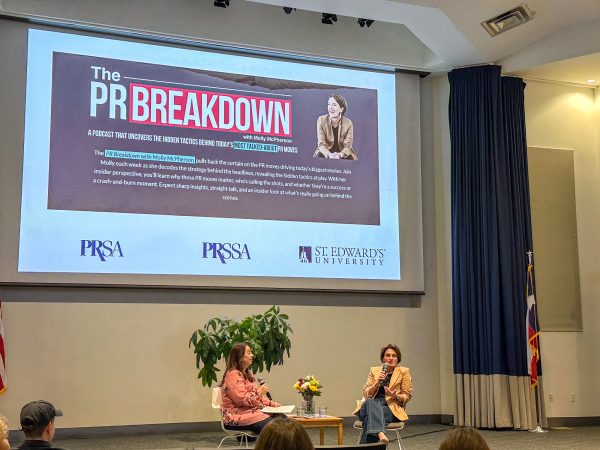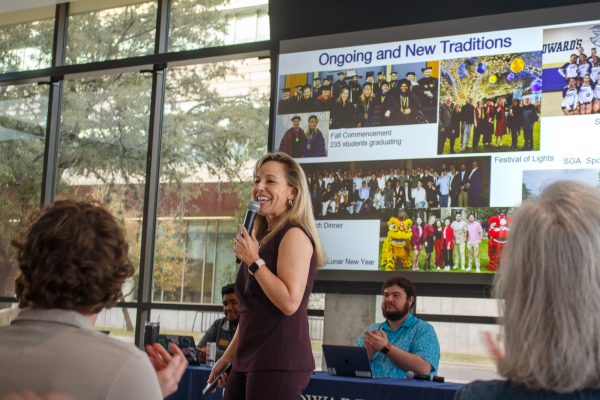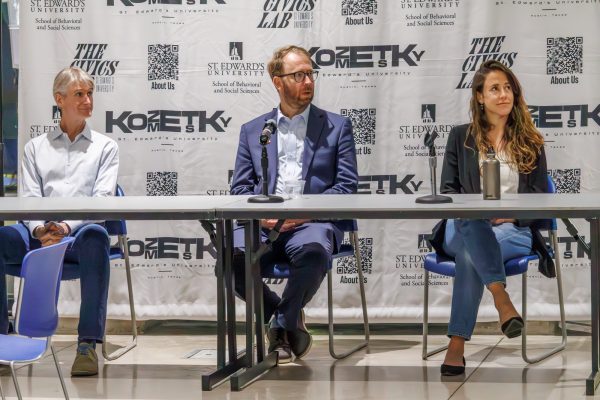Following enrollment shortfall university implements hiring frost, retirement offers
About half of the 67 members of the St. Edward’s University community who were recently offered voluntary early retirement are considering the option, Kim Kvaal, vice president of Finance & Administration confirmed this week. Reorganization, elimination of positions and what administrators describe as a, “hiring frost” are all part of an effort to present a balanced budget to the Board of Trustees for 2019.
“The University does not have a budget shortfall for FY18,” Kvaal wrote in emailed responses to questions from Hilltop Views. Kvaal wrote that those offered the voluntary retirement option have four weeks to decide and that she does not yet know which departments will be affected. The budget must be adjusted to adapt to the recent dips in enrollment and retention numbers.
“Every budget contains a contingency for unexpected circumstances,” Kvaal wrote. “And we are using those resources to address this year’s enrollment shortfall.”
Vice President of Student Affairs Lisa Kirkpatrick said that the official headcount for the first time freshman is 793. This number is 71 students short compared to the 864 headcount of the class of 2020. Those 71 students comprise an estimate of $3 million in annual tuition.
In an email sent to university faculty and staff, Associate Vice President for Human Resources Kim Van Savage described the hiring frost as part of a “cost-saving initiative.” The frost restricts hiring new or replacement employee to critical positions and/or part of the aforementioned initiative. Every hire must be reviewed by the office of the President.
Those offered the voluntary retirement option have reached retirement eligibility by June 30, 2018. Eligibility was determined by a formula: An employee’s age, plus benefits-eligible years of service must be equal to or greater than 80. The employee must also be at least 55 with at least 15 years of service by June 30, 2018.
Father Lou Brusatti, associate professor of Religious Studies and former Humanities Dean, accepted the offer. He said there is little to no pressure involved when an eligible employee receives the initial email notification from Human Resources.
“It’s a matter of yes or no,” Brusatti said. “And, if it’s no, then that’s your decision.”
Last month, during the President’s Address, President George E. Martin juxtaposed different universities against St. Edward’s in order to illustrate that other institutions are also facing struggles.
For example, Howard University laid off 200 employees, Catholic University eliminated 37 positions and reduced annual program costs by $10 million over three years and La Salle University had a $12 million budget shortfall and cut 3 percent of workforce due to Fall 2015 enrollment deficit. He even added a chart noting 130 that have closed between 1990 and 2014.
During his State of Our Campus address, also last month, Martin added that the universities that didn’t “deal with the issue and kept pushing it out and postponing it” which resulted in mass layoffs or closing the university. St. Edward’s, on the other hand, is “addressing the issue immediately.”
The challenge for these universities and St. Edward’s alike has been due heavily in part by dips in enrollment and retention numbers.
The retention rate between first and second year students for 2016 was 79.7 percent. In 2015, the rate was 80.5. In 2014 that number was 84.6 percent. According to Kirkpatrick, it is only during the last two years that the university has seen this “dip.”
Kvaal wrote: “14 students who requested housing who requested housing in the Pavilions have withdrawn from St. Edward’s. However their reasons for withdrawing were unrelated to the Pavilions project.”
The opening of the new on-campus apartments originally scheduled for this fall hit construction delays.
Kirkpatrick stressed that the reorganization and dip in numbers doesn’t meant the university is “in crisis.”
“This is about maintaining our commitment to our mission which is to educate student’s hearts and minds and ensure that we have business processes in place that allow us to be fiscally responsible and continue to serve students and improve the student experience,” said Kirkpatrick.
The budget will have to be rebalanced to account for the lower enrollment numbers when they are presented to the Board of Trustees, Kvaal said.
Mischelle Diaz, director of Communications, said that the university set very “aggressive goals” regarding enrollment and retention. Setting the bar high comes with certain challenges and obstacles and the university is only just feeling them now.
“The university is experiencing some consequences of its own aiming high, which isn’t a bad thing,” says Diaz. “We aimed high, we met these goals and sometimes when you set the bar high you don’t make it.”
The most recent reorganizations and eliminations of departmental positions fall under the effects of the Strategic Plan 2022.
“The idea is, as leadership, we have to look at what’s happening around us, what’s happening to us and make incremental responsive decisions so that we don’t have a business crisis five years from now,” said Kirkpatrick. “It’s a responsive measure because we’re responding to the higher education landscape as it’s impacting us but also as we’re looking into the future and considering what’s to come.”
Specifically speaking for the Division of Student Affairs, Kirkpatrick acknowledged the difficulty that comes with losing influential members of the community.
“Organizational change is hard because it means that people who have been major contributors, people who we see everyday, might now be with us because we’ve had to eliminate positions and reorganize in a way that’s responsive to what’s coming and what is,” said Kirkpatrick. “If we do it now, then five years from now, we won’t be reacting, it’s better to be in a responsive space than a reactive space.”
Within the Division of Student Affairs specifically, five positions have been eliminated: Director of Orientation and Student Transitions, Marisa Lacey; Assistant Director of Student Life, Dave Gallander; Administrative Assistant, Sara Beth Cowe; and Administrative Assistant for the Health and Counseling Center Sirritta Roundtree. The fifth position, in Residence Life, is a hall director position that will not be refilled.






